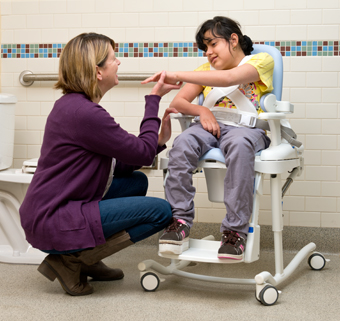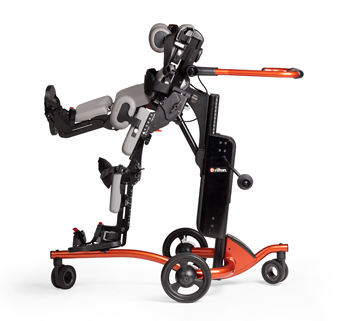Prospective cohort studies can inform pediatric physical therapy practice
| February 2019 The field of pediatric physical therapy has long recognized the difficulty of conducting high level research with the cerebral palsy population. Meeting the qualifications of a randomized controlled trial while implementing interventions with children with multiple physical disabilities – with all their varied daily realities – is extraordinarily difficult.
The field of pediatric physical therapy has long recognized the difficulty of conducting high level research with the cerebral palsy population. Meeting the qualifications of a randomized controlled trial while implementing interventions with children with multiple physical disabilities – with all their varied daily realities – is extraordinarily difficult.
In turn, the systematic review that selects from available research will often point out the necessity for individual studies to include the specific clinical features of the particular sub-population of CP that was studied. They point out that knowing these important aspects would make the study findings more applicable for those wishing to use evidence in clinical decision-making. Other critiques have cautioned that perhaps our over-arching goal of establishing evidence of treatment efficacy for the whole population of children with CP is putting us in the position of over-simplifying a very complex health condition.
Recently published articles are suggesting that the use of prospective cohort studies may help us take a step back and understand underlying factors associated with children’s outcomes. This in turn can help guide our intervention in individual cases. A prospective cohort study is where we have a larger population of children with cerebral palsy who are observed and followed from a baseline starting point on into the future. This type of study looks at how those future outcomes differ across the population, and considers the specific factors that may have affected those outcomes.
The following four article abstracts offer examples of such research. However, even as we reach conclusions from longitudinal cohort studies, it is important to reflect that these outcomes only reveal the existing factors. There may yet be relevant discoveries in the future to impact choices in intervention that, for now, remain “outside the box.”
1.
“A Collaborative Approach to Decision Making” discusses focus of intervention to improve these areas for children with cerebral palsy: (1) motor function, (2) self-care performance, and (3) participation in family and recreation activities.
The authors’ recommendations are drawn from two multisite prospective cohort studies (Move & PLAY and On Track). The Move & PLAY study evaluated 429 children with CP aged 18 months to 5 years, with follow-up points over one year. The determinants of the key outcomes were as follows, suggesting that these are to be focus areas of intervention: motor function was determined by primary and secondary impairments, adaptive behavior, and participation in community programs; self-care participation was determined by motor abilities, primary impairments, health, adaptive behavior, attributes of family, and services that met needs; while participation in family and recreation activities was determined by motor abilities, adaptive behavior, attributes of family, and participation in community programs.
The On Track study then looked at how these measures change over time, and how they vary within subgroups of children with CP. This study followed 708 children with CP aged 18 months to 12 years across one to five study visits. Once available in the public domain, new knowledge from the On Track Study will provide more specific percentile-type information on the average development for children with CP aged 18 months to 12 years for balance, range of motion, muscle strength, endurance, impact of health conditions, performance in self-care, and participation in family and recreation activities. This in turn can offer prognostic information and guide intervention.
Reference:
Bartlett DJ, McCoy SW, Chiarello LA, Galuppi B. (2018) A Collaborative Approach to Decision Making Through Developmental Monitoring to Provide Individualized Services for Children With Cerebral Palsy. Physical Therapy 98:10:(865–875.) Abstract (Full Text available to APTA members) https://academic.oup.com/ptj/article/98/10/865/5049484
2.
“Activity Performance Curves of Individuals with Cerebral Palsy” summarizes findings from a longitudinal assessment on 421 participants with CP from ages 1 to 20 years at baseline; those with intellectual disability were followed for up to a 13-year period. These children and youth were from GMFCS levels I to V.
The researchers wanted to determine the age at which children reached 90% of the upper limit of performance (or the average maximal performance level). The assessments separated findings of motor performance and findings of daily activity performance.
For motor performance, they found that the upper limits decreased with each GMFCS level. For children at GMFCS Levels I-III, the upper limit mark was reached at 6-8 years of age (and younger for GMFCS Levels IV and V). Note the researchers concluded that individuals with CP continue to develop motor performance after gross motor capacity limits are reached.
For daily activity performance, for those children without intellectual disability, the upper limit did not differ for children Levels I to III. The upper limit mark for performance of daily activities was reached between ages 11 and 14 years (for personal daily activity), ages 26 and 32 years (for domestic), and ages 22 and 26 years of age (for community daily activity). The researchers concluded that daily activities continue to develop for individuals without intellectual disability into their 20s. However, individuals with intellectual disability reached lower daily activity performance limits earlier.
So for motor performance, individuals who are severely affected have the least favorable development, and for daily activity performance, those with intellectual disability have the least favorable development.
Reference:
van Gorp M, Roebroeck ME, Tan SS, de Groot V, Gorter JW, Smits DW, Schmidt AK, Dallmeijer AJ, PERRIN DECADE Study Group. (2018) Activity Performance Curves of Individuals With Cerebral Palsy. Pediatrics, 142(5):1-10. doi: 10.1542/peds.2017-3723. Abstract https://www.ncbi.nlm.nih.gov/pubmed/30287591
Abstract http://pediatrics.aappublications.org/content/142/5/e20173723
3.
“Longitudinal trajectories of physical activity and walking performance” involved 79 children with cerebral palsy who were GMFCS levels I–V. The average age of the participants was 7.6 years.
The children wore data-collecting devices during their day-to-day activities to monitor their physical activity as well as to measure walking performance (specifically related to number of strides and speed of strides).
Physical activity data was analyzed for all participants. Interestingly, the children with CP did NOT display plateaus in physical activity based on functional level. The data showed that children across all GMFCS levels showed a decrease in amount and intensity of physical activity from 3.0 to 12 years old. In fact, the GMFCS Level 1 participants demonstrated the steepest decline in the amount and intensity of physical activity from 3.0 to 12 years old.
Walking performance data was analyzed for children in GMFCS Levels I – III. Again, participants did NOT display plateaus in walking performance based on functional level. Children in GMFCS level I decreased slightly in walking performance measures from 3.0 to 12 years old, while children in GMFCS level II increased slightly in walking performance measures from 3.0 to 12 years old.
With this research, the longitudinal curves demonstrated variations in physical activity and walking performance by functional level. There was no plateau. These trajectories determined by research findings can support collaborative intervention planning between therapists and families relative to physical activity and walking performance.
Reference:
Bjornson K, Fiss A, Avery L, Wentz E, Kerfeld C, Cicirello N, Hanna SE. (2019) Longitudinal trajectories of physical activity and walking performance by gross motor function classification system level for children with cerebral palsy. Disabil Rehabil. Jan 7:1-9. doi: 10.1080/09638288.2018.1534995. [Epub ahead of print] Abstract: https://www.ncbi.nlm.nih.gov/pubmed/?term=30616403
4.
“Factors Associated with Enhanced Gross Motor Progress” is based on a prospective cohort study in Norway, following 442 children (256 boys, 186 girls) aged 2-12 years. This same research was also published in the journal Disability Rehabilitation and has been previously featured on Rifton’s blog as well as on Your Therapy Source.
Their findings? The only intervention factor associated with enhanced gross motor function was participation in three or more sessions per week (intensive training or intensive program). On average, gross motor function was lower in children with intellectual disability. Finally, they concluded that preventing ankle contractures appears important for gross motor progress.
Reference:
Størvold GV, Jahnsen RB, Evensen KAI, Romild UK, & Bratbert GH. (2018) Factors Associated with Enhanced Gross Motor Progress in Children with Cerebral Palsy: A Register-Based Study. Physical & Occupational Therapy In Pediatrics. 38:5(548-561.) doi: 10.1080/01942638.2018.1462288.
Abstract on PubMed: https://www.ncbi.nlm.nih.gov/pubmed/?term=29714626
Abstract: https://www.tandfonline.com/doi/abs/10.1080/01942638.2018.1462288




